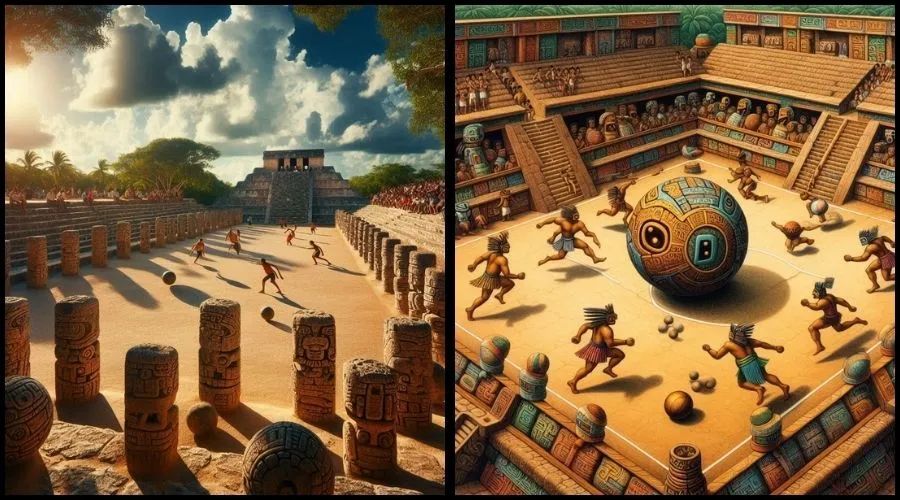The ancient sport of Pitz, also known as the Mesoamerican ballgame, is deeply ingrained in the Mayan history and culture. This game was more than just a source of fun; it was closely linked to religious beliefs, societal structures, and even politics.
Let’s explore the interesting realm of the Mayan ball game. In this post, we’ll look at the history, regulations, and significance of Pitz. We’ll also talk about the playing field, the ball, and what it meant to the Mayans.
The Mayan Ball Game
Ancient societies such as the Olmecs played the Mayan ball game known as Pitz, which afterward gained popularity among the Maya. This game has a history of more than 3,000 years.
It was played throughout Mesoamerica, including what is now Mexico, Belize, Guatemala, Honduras, and Salvador. The game used a rubber ball and was played on a special court known as a ballcourt, which represented the city’s wealth and power.
The game was known by several names across cultures, including ōllamaliztli among the Aztecs and pitz among the Maya.
History Of Pitz
1. Origins
Pitz, the Mayan ball game, has origins dating back to around 1400 BCE. It is believed that the Olmecs, an ancient Mesoamerican culture, were the first to play this game. They passed it on to the Mayans, who then made it an important part of their society.
2. Evolution
Over the centuries, Pitz changed and evolved. The rules and the way it was played also changed. The Mayans built special ballcourts for the game, which can still be seen in ancient cities like Chichen Itza and Tikal. The game was more than just a sport; it was a ritual with deep religious and political significance.
Rules Of The Game
1. Objective
Pitz’s main goal was to keep the ball in play. Players used their hips, thighs, and forearms to hit the ball. The ultimate aim was to pass the ball through a stone hoop mounted high on the court’s wall, which was very difficult. Most games focused on keeping the ball in motion without letting it touch the ground.
2. Teams
Pitz was usually played by two teams. Each team had one to four players. The number of players could vary depending on the game’s purpose and the size of the court.
3. The Ball
The ball used in Pitz was made of solid rubber and could weigh up to 9 pounds (about 4 kg). This made the game physically demanding and sometimes dangerous. Injuries were common.
4. Scoring
Scoring in Pitz was different from modern sports. Points could be scored in various ways, such as hitting the ball through the hoop or forcing the other team to let the ball touch the ground. Each court and game could have its own set of rules.
The Ball Court
1. Structure
The ball court, called “tlachtli” in Nahuatl, was a large rectangular field. The sides of the court were sloped, and stone rings were placed high on each side. The size of the court varied, but they were usually about 100 to 200 feet long and 30 to 40 feet wide.
2. Symbolism
The ball court had symbolic meaning. It represented the world, with the ball symbolizing the sun. Playing the game was a way to honor the gods and ensure the sun’s movement across the sky. The court was often decorated with carvings and paintings of gods and mythical scenes.
Game Facts
1. Gender & Age
Both men and women played Pitz, though men were the main players in most serious games. Children also played a simpler version of the game to learn the skills needed for the adult version.
2. Training & Skills
Playing Pitz required strength, agility, and endurance. Players trained for years to master the game. They needed strong hips and legs to hit the heavy rubber ball and quick reflexes and strategic thinking to keep the ball in play.
3. Clothing & Gear
Players wore protective gear made of leather and cloth, including belts, pads, and helmets. This gear helped protect them from the heavy ball and the rough playing surface. The clothing also had symbolic meanings and was often decorated with images of gods and animals.
Religious And Cultural Significance
1. Connection To The Gods
Pitz was more than just a game; it was a religious ceremony. The Mayans believed that the gods had given them this game, and playing it was a way to communicate with the gods. It was often played during important festivals and religious events.
2. Human Sacrifice
One of the most talked-about aspects of Pitz is human sacrifice. In some games, the losing team’s captain or even the entire team might be sacrificed to the gods. This was seen as an honor rather than a punishment. Sacrificing the players was believed to please the gods and ensure good harvests and prosperity.
3. Political Tool
Pitz also had political significance. Leaders used the game to settle disputes between cities or factions. Instead of going to war, they could play a game of Pitz, and the outcome would decide the winner.
In Modern Times
1. Rediscovery
Pitz was forgotten for many centuries after the fall of the Mayan civilization. However, archaeologists rediscovered the game in the 20th century. They found ball courts in ancient Mayan cities and studied carvings and texts that described the game.
2. Revival
Today, there is a renewed interest in Pitz. Some communities in Mexico and Central America have started to play the game again. They hold tournaments and festivals to celebrate this ancient sport. The modern version of Pitz is less dangerous, with modified rules and lighter balls.
3. Cultural Preservation
Reviving Pitz is seen as a way to preserve Mayan culture. It helps people connect with their heritage and keep ancient traditions alive. Schools and cultural centers teach the game to young people, ensuring that the legacy of Pitz continues.
Importance Of The Game
1. Historical Significance
Pitz offers valuable insights into the Mayan civilization, showing us how they lived, what they valued, and how they worshipped their gods. The game is like a window into their world, helping us understand their society and culture.
2. Influence On Modern Sports
Pitz has influenced many modern sports. The idea of a ball game played with teams and a goal is similar to soccer, basketball, and other contemporary sports. Studying Pitz helps us see the roots of these games and appreciate the innovations of ancient cultures.
3. Symbol Of Resilience
The revival of Pitz is a symbol of resilience. Despite centuries of colonization and cultural suppression, Mayan heritage survives. Playing Pitz is a way for modern Mayans to reclaim their identity and celebrate their history.
Political Implications
Pitz also had political significance. It was sometimes used to settle disputes between rival cities without resorting to war.
The outcome of the game could determine the fate of captured kings or nobles, who might be sacrificed to the gods if their team lost. This practice highlighted the game’s role in maintaining social order and resolving conflicts.
Archaeological Evidence
Archaeological findings have provided insight into the historical significance of Pitz. Many ancient ball courts have been discovered, ranging from Mexico to as far north as Arizona.
These sites often include murals and carvings that depict players, rituals, and the game’s connection to mythology.
FAQs
The purpose of the Mayan ball game was to honor the gods and communicate with them. It was also used to settle disputes between cities or factions. The game had deep religious, cultural, and political meanings.
Q.2 What happened to the losers of the game?
In some games, the losers, especially the losing team’s captain, were sacrificed to the gods. This was seen as an honor and a way to please the gods. However, not all games ended in sacrifice.
Conclusion
Pitz, the ancient Mayan ball game, is a fascinating part of Mesoamerican history. It was more than just a game. It was a religious ritual, a political tool, and a symbol of Mayan culture.
Understanding Pitz helps us appreciate the complexity and richness of the Mayan civilization. Today, as communities revive this ancient sport, the legacy of Pitz continues. It connects the past with the present, keeping the spirit of the Mayan people alive.







